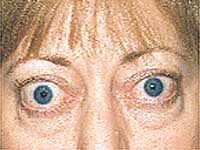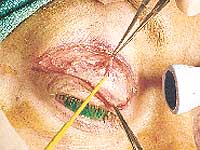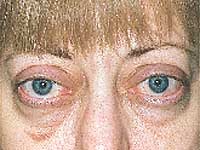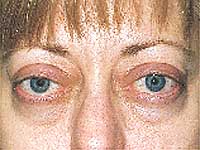The subcutaneous approach to upper eyelid retraction has many advantages
Using this approach allows the physician to perform a cosmetic blepharoplasty while correcting the eyelid retraction.
Upper eyelid retraction can be treated surgically by numerous techniques. The basic two approaches are through the conjunctiva or the skin. Various surgeons have developed different procedures within each of these two basic routes. One of the advantages of the transcutaneous approach is the ability to do a cosmetic blepharoplasty while correcting the eyelid retraction.
Radiosurgery facilitates this method by decreasing bleeding, especially when dissecting Muller’s muscle from the underlying conjunctiva. Ellman International (Hewlett, N.Y.), which manufactures the patented Surgitron, has developed the Empire Microincision Needle Electrode that is narrow at the point but widens as it gets closer to the handle. The Empire needle design evolved from the Fine surgical tungsten needle electrodes used for gingival retraction in the oral cavity. The advantage of this design is that the micro-sharp tip concentrates the radiofrequency energy, resulting in minimal thermal damage to the adjacent tissue. This results in a thin skin incision with minimal scarring. Penetrating deeper into the tissues utilizes the wider part of the needle. More surface contact with the tissues gives better hemostasis for cutting through orbicularis muscle and peeling Muller’s muscle from the underlying conjunctiva. The waveform selection and power must be changed when going from cutting skin to muscle, but the needle may remain the same.
Technique
The technique that I prefer is a recession of the levator aponeurosis and Muller’s muscle. After the patient is placed on the operating table, lines are drawn to outline the amount of skin to be removed. The skin is prepped and then injected with the anesthetic. I use a combination of 2% lidocaine with epinephrine, 0.05% Marcaine (bupivacaine HCl; Abbott) with epinephrine, and hyaluronidase. The enzyme is mixed one part to 10 parts of the anesthetic. The patient is prepped and draped while the surgeon scrubs.
The surgeon must try a few power settings until the needle slides easily through the tissues with no drag and no sparks. This will give the best wound with the least scarring. The touch must be very light, since the cutting is done with the radio waves and no pressure is needed from the surgeon. The strokes should be relatively rapid, without sacrificing accuracy. The more time spent in one spot, the more coagulation and tissue destruction. Once the skin incision is created, a slower stroke will promote better hemostasis. I believe it would be worthwhile for the surgeon who has not used the Ellman Surgitron to attend an instruction course on radiosurgery. This would allow the surgeon to become familiar with the instrument, since the cutting technique is different than when using a scalpel.
Using the hemo setting, dissection is continued to expose the superior 3 to 4 mm of the anterior tarsus. The attachments of the levator aponeurosis are freed from the tarsus. If the retraction is minimal, the patient may be asked to sit up and the results evaluated. Releasing the levator rarely will give enough recession to effect a cure. In the majority of cases, Muller’s muscle must be released from the tarsus and the underlying conjunctiva. Radiofrequency surgery is very helpful in this step because these tissues are very vascular. With the needle on the hemo setting, Muller’s muscle is tented away from the conjunctiva and the connecting fibers are slowly cut with the Empire needle. Dissection should continue laterally, but care must be taken not to injure the lacrimal ducts. The patient is asked to sit up numerous times so that lid height can be frequently evaluated during this process. If the lateral height remains too high and I am concerned about injuring the lacrimal ducts by dissecting too far laterally, I will often perform a small lateral tarsorrhaphy. This has the effect of closing the lateral angle, resulting in a pleasing lid curve.
I usually find that a 10-mm lid retraction corrects about 3 mm of recession. I make my judgment of the final height with the patient in the sitting position. I try to set the lid about 1 mm below the final desired height. Since epinephrine is probably causing some eyelid retraction, the lid will drop even further during the initial postoperative period. Once the lid height is acceptable, I close the skin with a running polypropylene suture.
Antibiotic ointment is continued for 1 week. Cold compresses are used for 24 to 36 hours. Some swelling lasts a week or more. During this period, a 1 to 2 mm overcorrection is expected.
I have found the levator aponeurosis and Muller’s muscle recession to be a very effective procedure for over 20 years. With radiofrequency surgery at 4 mHz, the operation is faster because of less bleeding, and patient healing seems to be quicker with less swelling.
|
|
|
|
|
|
For Your Information:
- Jay Justin Older, MD, can be reached at Ophthalmic Plastic Surgery Associates, 4444 E. Fletcher Ave., Ste. D, Tampa, FL 33613; (813) 971-3846; fax: (813) 977-2611; Web site: www.eyelids.net. Dr. Older has no direct financial interest in any of the products mentioned in this article. He is a paid consultant for Ellman International.
- Ellman International can be reached at 1135 Railroad Ave., Hewlett, NY 11557-2316; (516) 569-1482; fax: (516) 569-0054; e-mail: ellman@ellman.com.




